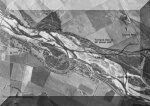
Popular history has it that the Wright Brothers at Kitty Hawk in the US were the first to fly, but this is not true! The first actual flight was by a rather clever New Zealander chap by the name of Richard Pearse. Pearse is not generally known outside New Zealand for this wonderful feat, as there has been very little publicity about it, the first real mention of his achievement being in the newspaper in 1909.
Richard was an enthusiast, and perhaps a turn of the century 'mad scientist' type inventor. Certainly most of his other creations - mostly to do with farm machinery - were far from the mainstream and thus didn't get much credit.
But he did get a few things right on his flying machine that were amazingly advanced for the time. Here's a photo of a replica of the flying machine, where Man's first powered flight took place in a little-known place on the south island of New Zealand called Waitohi, just near Timaru.

The witnesses' account of the flight vary, from "50 to 400 yards in length", but it seems most likely that it was around 350 yards long, and it ended prematurely when the flying machine landed in a large hedge - 4 metres off the ground!
The
aircraft was the first to use proper ailerons, instead of the wing
warping system that the Wright's used. The flying machine also had a
modern tricycle type landing gear, thus negating the need for ramps,
slides, or skids. Any suitable road would do. The flying machine was
aerodynamically crude, for sure, but did the job on the day, and in
fact for months afterwards. By the end of July 1903, Pearse had
achieved flights of around 1 kilometre in length, and perhaps even more
amazingly, some of them included turns! An absolutely fantastic
achievement
for the time.
Pearse also
built the
engine, which was estimated at about 15 - 22hp, but hampered by a much
cruder
propellor than the Wright's machine.
He didn't
realise the
historic importance of the event, and so he didn't bother to have any
photographs
taken of his machine flying, though there is extensive evidence from
witnesses
describing his flights.
The early
series of flights where on these dates -
- 31-3-1903 -
First
powered flight. Estimated distance around 350 yards. Similar to the
first Wright
Brothers flight, ie, in a straight line, and
barely controlled. (Some witnesses claim the flight was on that date,
but 1902)
- March 1903. After spending a year working on the engine, and tending to his farm, Pearse made another flight, this time with a distance of only about 150 yards. (This is why the 1902 flight is quite possible)
-
11-5-1903. This, my my opinion, was Man's first real flight.
Pearse took off along the side of a river, the Opihi River, turned left
to fly over the 30' tall river bank, then turned right to fly parallel
to the middle of the river, above the wing's ground effect. After
flying nearly 1,000 yards, his engine began to overheat and lost power,
thus forcing a landing way down the dry-ish riverbed. One of the
locals, Arthur Tozer, was crossing the river at the time in a
horse-drawn carriage, and was rather surprised to have Pearse
fly right
over his head!
Here's a
picture of
the river, and Pearse's flight path.

- 10-7-1903 Again, distance unknown, but the aircraft was (yet again!) stuck in a hedge many feet above the ground until the snow melted some time later.
While these dates are as certain as they can be, is is clear that Pearse flew many other times, perhaps as early as 1901. (Though this was behind being towed by two horses.) It is also believed that he also continued to make many other flights in the privacy of his own property, which as you may have guess had some very large gorse hedges around it. His desire for privacy was no doubt a major restriction in his ability to find a clear area to fly for any great distance.
The engine that he made was extremely clever, I think. It was a twin cylinder and piston device, but the pistons worked in both directions so that it was effectively a four cylinder & piston engine. Click on the picture below for a much larger view of the engine.

He made a brief return in the mid 1930's, when designed and partly built an aircraft that would've revolutionised air travel for the masses - It had fold up wings and a tail so it could be put into a conventional garage. The engine could be run as either a 2 stroke or a 4 stroke, and also either supercharged or naturally aspirated. Also, the entire engine/prop assembly pivoted so that the aircraft could do a vertical takeoff and landing. It was never finished, for various reasons.
Richard William Pearse was born in 1877, and died in a hospital in 1953.
So when you look up at an aircraft flying above you, please remember that the true story is that a reclusive farmer from the cold south island of New Zealand was the first to create history - He deserves the credit he's due.